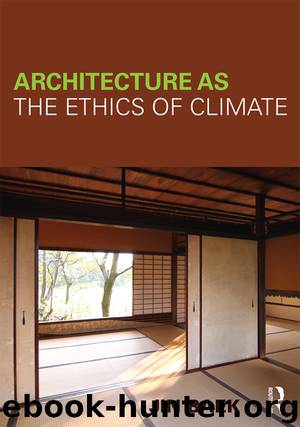Architecture as the Ethics of Climate by Jin Baek

Author:Jin Baek
Language: eng
Format: epub
Publisher: Taylor & Francis
Published: 2016-03-18T04:00:00+00:00
3
THE ECOLOGY OF ‘WE’ AND AMBIENT WARMTH
Richard Neutra’s ecological architecture
Distanced from any romantic position of the natural such as that of Frank Lloyd Wright (1867–1959), Richard Neutra (1892–1970) saw the natural as imbalanced, if not imperfect. Human intervention is thus expected. This intervention is not for the sake of the anthropocentric and instrumental appropriation of nature and its resources, but rather intended for the restoration of balance between the different forces or qualities of the natural, articulating their right relationship peculiar to the character of a human abode. What is further important in reference to this human intervention is Neutra’s sense of ecology. It is true that establishing the right relationship among natural conditions is an essential aspect of his ecological perspective. His sense of ecology, however, became further joined with the ethical dimension of the inter-personal that a human abode necessarily suggests. Indeed, the response to the natural and the dynamic of the inter-personal were not viewed as two different aspects, since the former operated as the agency that activated the latter. For Neutra, more fundamental than man’s singular relationship with nature or natural resources was the inter-personal sharing of ‘we,’ in which scarcity itself becomes the medium of a proportionate joining. The coordination of a human relationship, such as a joint measure in coping with a natural condition, is a crucial factor that characterizes a setting to be ecological.
In further apprehending Neutra’s notion of the environment and the correlate significance of human creation, his comment on the thermal quality of traditional Japanese architecture and its role in formulating the inter-personal encounter is essential. Neutra’s interest in Japanese culture was undeniable. He often confessed his admiration of Japanese culture, he gave lectures in Japan in the 1930s and the early 1950s, and wrote about Japanese culture.1 While these historiographical facts do add a degree of justification to this attempt to conjoin Neutra’s architecture with Japanese philosophy, it is indeed in the theoretical connections that this section has more interest. Like Tetsuro Watsuji (1889–1960), Neutra apprehended a given context as consisting of invisible yet concrete forces. Creation for Neutra is concerned not with any imagery or code but with the coordination of the forces of fudo. In this regard, of particular interest is how Neutra established the relationship among fire, wind and water, and how he further conjoined this dialectical ensemble of the primary elements of cosmos with a daily setting for inter-personal activities. In particular, in underpinning Neutra’s sense of the inter-personal communication in an atmosphere and the reciprocity between the natural and the inter-personal, this section adopts Watsuji’s notion of an ego-less perceptual engagement with the surrounding and its trans-subjective communication of the ‘we.’ Watsuji’s account of how one’s relationship with the natural necessarily involves the dimension of the inter-personal is particularly significant for illuminating Neutra’s practice, the goal of which was to secure a place for the inter-personal through the coordination of natural forces.
Download
This site does not store any files on its server. We only index and link to content provided by other sites. Please contact the content providers to delete copyright contents if any and email us, we'll remove relevant links or contents immediately.
Kathy Andrews Collection by Kathy Andrews(11345)
The remains of the day by Kazuo Ishiguro(8419)
Paper Towns by Green John(4815)
Spare by Prince Harry The Duke of Sussex(4807)
Industrial Automation from Scratch: A hands-on guide to using sensors, actuators, PLCs, HMIs, and SCADA to automate industrial processes by Olushola Akande(4636)
The Body: A Guide for Occupants by Bill Bryson(4603)
Machine Learning at Scale with H2O by Gregory Keys | David Whiting(3671)
Be in a Treehouse by Pete Nelson(3655)
Harry Potter and the Goblet Of Fire by J.K. Rowling(3620)
Never by Ken Follett(3552)
Goodbye Paradise(3464)
The Remains of the Day by Kazuo Ishiguro(3148)
Into Thin Air by Jon Krakauer(3139)
The Cellar by Natasha Preston(3081)
The Genius of Japanese Carpentry by Azby Brown(3045)
Fairy Tale by Stephen King(2978)
120 Days of Sodom by Marquis de Sade(2947)
Drawing Shortcuts: Developing Quick Drawing Skills Using Today's Technology by Leggitt Jim(2943)
The Man Who Died Twice by Richard Osman(2824)
